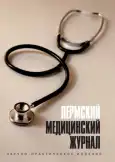BIOELECTRIC MUSCLE ACTIVITY INDICES IN TREATMENT OF PATIENTS WITH INFANTILE CEREBRAL PARALYSIS IN THE FORM OF SPASTIC DIPLEGIA
- Authors: Eliseev VV1
-
Affiliations:
- Алтайский государственный медицинский университет
- Issue: Vol 33, No 3 (2016)
- Pages: 56-61
- Section: Articles
- URL: https://journals.rcsi.science/PMJ/article/view/5670
- DOI: https://doi.org/10.17816/pmj33356-61
- ID: 5670
Cite item
Full Text
Abstract
Full Text
##article.viewOnOriginalSite##About the authors
V V Eliseev
Алтайский государственный медицинский университет
Email: Evictory08@yandex.ru
аспирант кафедры медицинской реабилитологии с курсом ФПК и ППС
References
- Барбаева С.Н., Кулишова Т.В., Шумахер Г.И., Клыжина Е.А., Роменский В.М. Применение нейроэлектростимуляции в комплексной реабилитации больных детским церебральным параличом. Физиотерапия, бальнеология и реабилитация 2007; 3: 37-39.
- Зарипова Ю.Р., Мейгал А.Ю. Влияние среды пребывания на нейромышечный статус новорожденных детей разного гестационного возраста. Экология человека 2013; 4: 13-18.
- Зыков В.П., Заваденко Н.Н., Холин А.А., Медведев М.И. Достижения в детской неврологии за последние 20 лет. Доктор.Ру 2012; 5: 45-49.
- Кадыков А.С., Черникова Л.А., Шахпаронова Н.В. Реабилитация неврологических больных. М.: МЕДпресс-информ 2009; 560.
- Кравцова Е.Ю., Щеколова Н.Б., Мудрова О.А., Новикова Е.А., Обухов А.С. Синусоидальные модулированные токи в комплексной реабилитации больных с детским церебральным параличом в течение учебного года. Вопросы курортологии, физиотерапии и лечебной физической культуры 2013; 2: 38-41.
- Малышкина А.И., Филькина О.М., Песикин О.Н., Назаров С.Б., Долотова Н.В. Региональная модель катамнестического наблюдения на 1-м году жизни детей с очень низкой и экстремально низкой массой тела при рождении. Здравоохранение Российской Федерации 2014; 6: 53-56.
- Петрушанская К.А., Витензон А.С. Восстановительное лечение больных детским церебральным параличом посредством функциональной электростимуляции мышц при ходьбе. Журнал неврологии и психиатрии им. С.С. Корсакова 2009; 1: 27-34.
- Попова О.Ф., Попова Е.С. Технологии медицинской реабилитации детей с детским церебральным параличом. Доктор.Ру 2012; 10: 65-68.
- Скоромец А.А., Скоромец А.П., Скоромец Т.А. Топическая диагностика заболеваний нервной системы. СПб.: Политехника 2007; 615.
- Смирнова И.В., Самсонова Т.В. Функциональная диагностика двигательной патологии в детском возрасте. Детская медицина Северо-Запада 2012; 3 (1): 36-40.
- Шамик В.Б., Тупиков В.А., Дьякова В.Н. Особенности биоэлектрической активности мышц голени у детей с детским церебральным параличом. Вестник травматологии и ортопедии им. Н.Н. Приорова 2012; 1: 61-63.
- Hägglund G., Wagner P. Spasticity of the gastrosoleus muscle is related to the development of reduced passive dorsiflexion of the ankle in children with cerebral palsy. Acta Orthopaedica 2011; 82 (6): 744-748.
- Kim W.H., Park E.Y. Casual relation between spasticity, strength, gross motor function and functional outcome in children with cerebral palsy: a path analysis. Developmental Medicine & Child Neurology 2011; 53: 68-73.
- Tomita H., Fukaya Y., Ueda T., Honma S., Yamashita E., Yamamoto Y., Mori E., Shionoya K. Deficits in task-specific modulation of anticipatory postural adjustments in individuals with spastic diplegic cerebral palsy. Journal Neurophysiology 2011; 105: 2157-2168.
- Warnink-Kavelaars J., Vermeulen R.J., Becher J.G. Study protocol: precision of a protocol for manual intramuscular needle placement checked by passive stretching and relaxing of the target muscle in the lower extremity during BTX-A treatment in children with spastic cerebral palsy, as verified by means of electrical stimulation. BMC Pediatrics 2013, available at: http://www.biomedcentral.com/ 1471-2431/13/129.
Supplementary files






